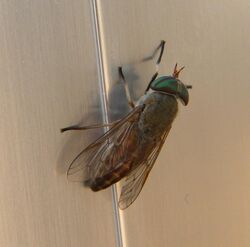Biology:Tabanus nigrovittatus
| Tabanus nigrovittatus | |
|---|---|

| |
| Scientific classification | |
| Domain: | Eukaryota |
| Kingdom: | Animalia |
| Phylum: | Arthropoda |
| Class: | Insecta |
| Order: | Diptera |
| Family: | Tabanidae |
| Subfamily: | Tabaninae |
| Tribe: | Tabanini |
| Genus: | Tabanus |
| Species: | T. nigrovittatus
|
| Binomial name | |
| Tabanus nigrovittatus Macquart, 1847[1]
| |
| Synonyms | |
Tabanus nigrovittatus, also known as the greenhead horse fly, salt marsh greenhead, or simply the greenhead fly, greenhead or greenfly,[7][8] is a species of biting horse-fly commonly found around the coastal marshes and wetlands of the Eastern United States . They are smaller than most horsefly species, instead being close in size to a common housefly. The biting females are a considerable pest to both humans and animals while they seek a source of blood protein to produce additional eggs:[9] greenhead larvae develop in the mud of salt marshes, and adult flies mate and lay their first group of eggs in the marsh, but to lay more eggs a female fly needs to drink an animal's blood, and so female greenheads which have laid eggs fly inland to look for prey in the area bordering the marsh; they can stay on land looking for animals to bite for up to four weeks.[9] Their bites are more painful than those of mosquitoes, since greenheads feed by cutting a wound in the skin with scissor-like mouth parts and sucking the blood released through it.[10] Females live for three to four weeks and may lay about 100 to 200 eggs per blood meal.[11] The eggs are laid on the grass in a salt marsh; the larvae live in the intertidal mud of the salt marsh for one or two years, preying on other invertebrates, before pupating in early spring.[9][12] The adult flies emerge in late spring and are most common from late June to August.[9][12][13]
Greenheads are large enough that their population cannot be controlled with insecticide without damaging the ecosystem.[9] Affected coastal communities install black box traps in marsh areas to reduce and control T. nigrovittatus populations.[10][14]
References
- ↑ Macquart, P.J.M. (1847). Diptères exotiques nouveaux ou peu connus. 2.e supplement. Paris: Roret. pp. 104 pp, 6 pls..
- ↑ Marten, J. (1883). "New Tabanidae". The Canadian Entomologist 15: 110-112. https://www.biodiversitylibrary.org/page/3099098#page/120/mode/1up. Retrieved 14 October 2022.
- ↑ Walker, F. (1850). Diptera. Part I, pp. 1-76, pls. 1-2. In [Saunders, W. W. (ed.)], Insecta Saundersiana: or characters of undescribed insects in the collection of William Wilson Saunders, Esq., F.R.S., F.L.S., &c. Vol. 1. London: Van Voorst. pp. 474.
- ↑ Szilády, Z. (1926). "New and Old World horseflies". Biologica Hung 1 (7): 1-30, 1 pl.
- ↑ Philip, C.B. (1957). "New records of Tabanidae (Diptera) in the Antilles". American Museum Novitates 1858: 16. https://digitallibrary.amnh.org/bitstream/handle/2246/2477//v2/dspace/ingest/pdfSource/nov/N1858.pdf?sequence=1&isAllowed=y. Retrieved 14 October 2022.
- ↑ Walker, F. (1848). List of the specimens of dipterous insects in the collection of the British Museum. part 1. London: British Museum. pp. 1–229.
- ↑ Moucha, J. (1976). "Horse-flies (Diptera: Tabanidae) of the World. Synoptic Catalogue.". Acta Entomologica Musei Nationalis Pragae Supplements 7: 1–320. https://www.aemnp.eu/data/article-975/956-7_0_7.pdf. Retrieved 11 September 2022.
- ↑ Burger, J. F. (1995). "Catalog of Tabanidae (Diptera) in North America north of Mexico". International Contributions on Entomology (Associated Publishers) 1 (1): 1-100.
- ↑ 9.0 9.1 9.2 9.3 9.4 Hansens, Elton; Race, Stuart. "The Greenhead and You". Rutgers. http://esc.rutgers.edu/fact_sheet/the-greenhead-and-you/.
- ↑ 10.0 10.1 Graves, Annie. "Greenhead Flies | What are Greenheads?". New England Network. https://newengland.com/yankee-magazine/living/pests/greenheads/.
- ↑ Stubbs, A.; Drake, M. (2001). British Soldierflies and their Allies.
- ↑ 12.0 12.1 "Greenhead Biology". https://www.ccmcp.net/greenhead-fly-control/pages/greenhead-biology.
- ↑ Hawk, Tim (2021-07-20). "New Jersey is powerless against greenhead flies. Here’s why.". https://www.nj.com/atlantic/2021/07/new-jersey-is-powerless-against-greenhead-flies-heres-why.html.
- ↑ Forman, Ethan (2022-04-13). "Gloucester takes aim at greenheads". https://www.gloucestertimes.com/news/gloucester-takes-aim-at-greenheads/article_96be156a-ba96-11ec-a488-8ff5d5b08ad3.html.
Wikidata ☰ Q7672903 entry
 |

